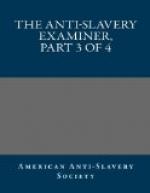As regards the comforts of the slaves in the vicinity of my residence, I can say they had nothing that would bear that name. It is true, the slaves in general, of a good crop year, were tolerably well fed, but of a bad crop year, they were, as a general thing, cut short of their allowance. Their houses were pole cabins, without loft or floor. Their beds were made of what is there called “broom-straw.” The men more commonly sleep on benches. Their clothing would compare well with their lodging. Whipping was common. It was hardly possible for a man with a common pair of ears, if he was out of his house but a short time on Monday mornings, to miss of hearing the sound of the lash, and the cries of the sufferers pleading with their masters to desist. These scenes were more common throughout the time of my residence there, from 1799 to 1831.
Mr. Hedding of Chatham county, held a slave woman. I traveled past Heddings as often as once in two weeks during the winter of 1828, and always saw her clad in a single cotton dress, sleeves came half way to the elbow, and in order to prevent her running away, a child, supposed to be about seven years of age, was connected with her by a long chain fastened round her neck, and in this situation she was compelled all the day to grub up the roots of shrubs and sapplings to prepare ground for the plough. It is not uncommon for slaves to make up on Sundays what they are not able to perform through the week of their tasks.
At the time of the rumored insurrection above named, Chatham jail was filled with slaves who were said to have been concerned in the plot. Without the least evidence of it, they were punished in divers ways; some were whipped, some had their thumbs screwed in a vice to make them confess, but no proof satisfactory was ever obtained that the negroes had ever thought of an insurrection, nor did any so far as I could learn, acknowledge that an insurrection had ever been projected. From this time forth, the slaves were prohibited from assembling together for the worship of God, and many of those who had previously been authorized to preach the gospel were prohibited.
Amalgamation was common. There was scarce a family of slaves that had females of mature age where there were not some mulatto children.
HIRAM WHITE
Otter Creek Prairie, Jan. 22, 1839.
TESTIMONY OF MR. JOHN M. NELSON—A NATIVE OF VIRGINIA.
Extract of a letter, dated January 3, 1839, from John M. Nelson, Esq., of Hillsborough. Mr. Nelson removed from Virginia to Highland county, Ohio, many years since, where he is extensively known and respected.




